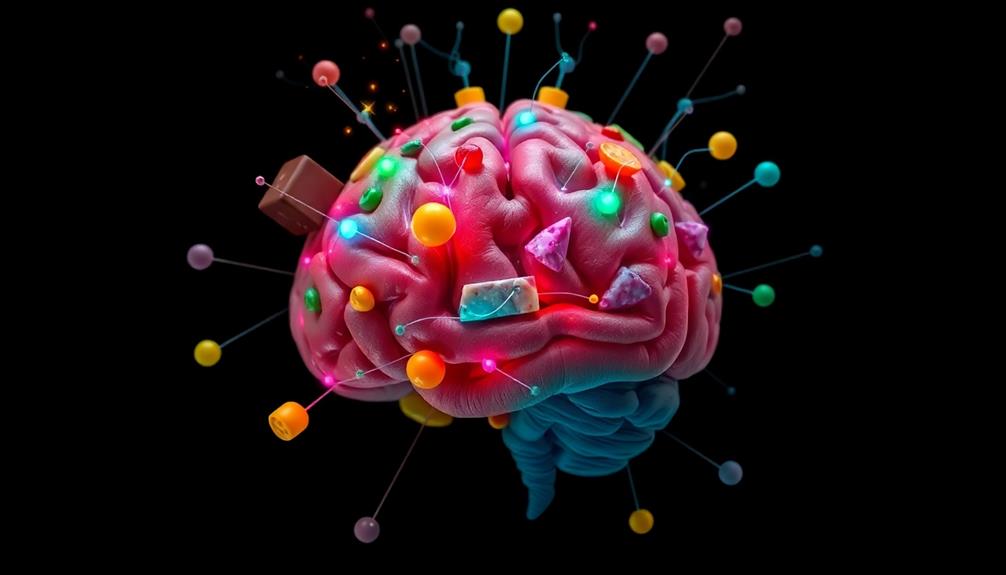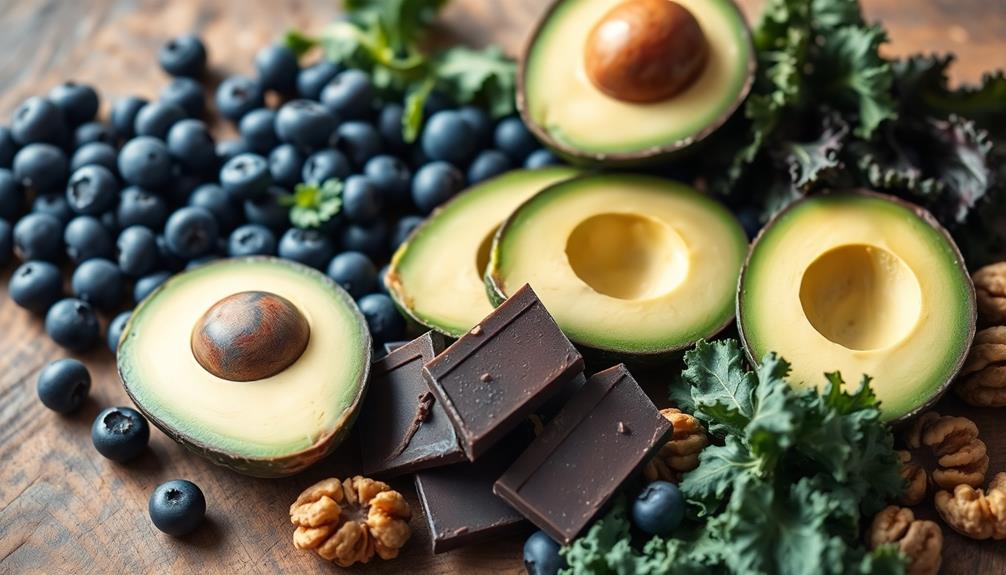Food-induced migraines stem from specific dietary triggers that affect individuals differently. Common culprits include alcohol, aged cheeses, processed meats, chocolate, and high-sodium foods. Your eating patterns also play an essential role; skipping meals can lead to blood sugar fluctuations that trigger migraines in many. To manage these headaches, regular meals every few hours, rich in proteins and fibers, are recommended. It's important to track your food intake and headache occurrences for better understanding and control. If you're curious about effective strategies and support networks that can help you manage migraines, there's plenty more to explore.
Key Takeaways
- Food triggers for migraines vary by individual, with common culprits including alcohol, aged cheeses, and processed meats.
- Skipping meals can lead to blood sugar fluctuations, triggering migraines in a significant percentage of sufferers.
- Regular eating patterns and small, frequent meals stabilize blood sugar levels, reducing the risk of migraine attacks.
- Keeping a headache diary helps identify dietary triggers and patterns related to migraine onset and frequency.
- Lifestyle factors, such as stress and sleep, also play a crucial role in the management of food-induced migraines.
Understanding Food Triggers

Understanding food triggers is vital for managing migraines effectively. Each person's experience with migraine triggers can differ greatly, making personalized dietary management important. Certain food items, like aged cheeses and processed meats high in nitrites, are common culprits, but they don't trigger migraines for everyone.
Additionally, traditional dishes like Caldeirada and rich desserts may also contain ingredients that could provoke symptoms. Alcohol consumption, particularly red wine, is another frequent offender.
To better understand your specific triggers, consider keeping a headache diary. This tool helps you track your food intake alongside migraine occurrences, enabling you to pinpoint potential sensitivities.
It's also important to note that skipping meals can trigger migraines in up to 57% of sufferers due to blood sugar fluctuations, so maintaining regular eating patterns can help stabilize those levels.
Moreover, some individuals may react negatively to artificial sweeteners like aspartame or foods rich in tyramine, which is found in aged foods and certain fruits.
Common Dietary Culprits

Many people frequently overlook common dietary culprits that can trigger migraines. Alcohol, especially red wine, is a well-known migraine trigger for many, alongside chocolate and aged cheeses.
Traditional Chinese dishes like Red-Braised Pork Belly can also contribute to migraine triggers due to their rich flavors and high sodium content. Processed meats high in nitrites or nitrates can also contribute to your migraine attacks. Additionally, foods containing MSG might surprise you as potential culprits, too.
Skipping meals is another significant factor; it can trigger migraines in up to 57% of sufferers due to fluctuations in blood sugar levels. Regular eating patterns are essential to managing your migraine frequency. You might want to pay attention to specific foods like citrus fruits, caffeine, and artificial sweeteners like aspartame, as they can affect individuals differently.
Moreover, consuming increased amounts of fried foods and processed meats has been linked to chronic migraines, highlighting how your dietary habits can impact the severity of your headaches.
To better understand your triggers, consider keeping a food diary. This tool can help you identify personal dietary triggers, empowering you to make informed choices about your eating habits and potentially reduce the frequency of your migraines.
Impact of Eating Patterns

Your meal timing can considerably impact your migraine risk. Skipping meals, especially breakfast, may lead to blood sugar fluctuations that trigger headaches.
Incorporating nutrient-dense ingredients like those found in Nettle and Potato Soup can provide essential vitamins and minerals that support overall health.
Meal Timing Importance
Meal timing plays an essential role in managing migraines, with research showing that skipping meals—especially breakfast—can trigger attacks in up to 57% of individuals.
Regular eating patterns are vital for stabilizing blood sugar levels, which helps reduce the risk of migraine attacks. Incorporating foods like turkey sandwiches can be a great way to guarantee you have a quick, nutritious meal on hand. By consuming small, frequent meals every 3-4 hours, you can minimize blood sugar fluctuations that often lead to headaches.
Fasting or irregular meal timings can increase the frequency of migraines in nearly half of sufferers, emphasizing the need for structured eating. Scheduled eating has been linked to better headache control, making it a key factor in your migraine management strategy.
To gain a clearer understanding of your unique triggers, consider keeping a headache diary. This tool can help you identify correlations between meal timing and migraine occurrences, allowing for more informed dietary decision-making.
Dietary Patterns Influence
Dietary patterns greatly influence migraine frequency and severity, with research showing that what you eat can be just as important as when you eat.
For instance, certain foods like aged cheeses and cured meats can act as common triggers for migraines, making it essential to be mindful of dietary choices. You mightn't realize that skipping meals can trigger migraines in up to 57% of individuals. This highlights the need for regular eating patterns.
Unhealthy eating habits, like consuming sweets, fried foods, and processed meats, often correlate with increased migraine severity and frequency of headaches.
To effectively manage migraines, consider maintaining small, frequent meals every 3-4 hours. This approach can help stabilize blood sugar levels and potentially reduce your migraine risks.
Additionally, structured diets that emphasize overall diet quality, such as incorporating fresh ingredients like those found in Pasta With Tomato Sauce, can provide therapeutic benefits beyond merely avoiding known food triggers.
Monitoring and Identifying Triggers

To effectively manage food-induced migraines, you should start by keeping a headache diary to track your food intake and headache patterns.
Exploring different culinary traditions, such as Asian Cuisine, can also help you identify potential triggers through varied ingredients.
Systematically testing for triggers through elimination and reintroduction can help pinpoint specific sensitivities.
Don't forget to take into account other lifestyle factors like stress and sleep, as they can complicate your findings.
Headache Diary Utilization
Keeping a headache diary can be a game-changer for anyone looking to understand and manage their migraines. By documenting your migraine frequency and intensity alongside your dietary intake, you'll start to uncover food triggers that may be contributing to your headache patterns.
For instance, enjoying dishes like Mushroom Masala might provide valuable insights if they correlate with your migraines. Make sure to note not just the foods you eat, but also meal timing and how these factors correlate with migraine onset.
When you record your meals and any headaches that follow, you can identify patterns that might indicate food sensitivity. For instance, studies show that nearly half of migraine sufferers experience attacks after skipping meals, so tracking meal timing is vital.
If you suspect certain foods are problematic, consider an elimination diet for four weeks, monitoring changes in your headaches during this time.
A headache diary provides you with valuable insights, allowing you to make informed dietary choices. By understanding your unique triggers, you can potentially reduce the frequency and severity of your migraines.
This proactive approach empowers you to take control of your health and find relief.
Systematic Trigger Testing
While identifying food triggers can feel overwhelming, systematic trigger testing offers a structured approach to understanding your migraines. By keeping a headache diary, you can track your dietary intake alongside headache occurrences, revealing patterns over time. To identify potential food triggers, eliminate suspected items from your diet for four weeks and monitor changes in migraine frequency and severity.
| Food Trigger | Status After Testing | Impact on Headaches |
|---|---|---|
| Dairy | No change | Not a trigger |
| Gluten | Reduced frequency | Possible trigger |
| Caffeine | Increased severity | Likely trigger |
Structured eating habits are essential during this process. Schedule your meals to avoid fasting, which may lead to blood sugar fluctuations—another potential migraine trigger. Remember, it's also important to take into account lifestyle factors, like stress and sleep, which can affect your results. By systematically testing and monitoring changes, you can pinpoint your personal triggers, leading to improved headache control and better dietary choices for a more enjoyable life.
Lifestyle Factors Consideration
Lifestyle factors play an essential role in managing migraines, and recognizing their impact can help you identify your triggers more effectively. For example, certain comfort foods, like squash casserole, may be enjoyed during family gatherings but could potentially trigger migraines in some individuals.
Keeping a headache diary is a powerful tool for tracking your food consumption alongside headache occurrences. By monitoring headache patterns over time, you can pinpoint potential food triggers that may be affecting you. Systematic testing of food sensitivities can also be valuable; eliminate suspected trigger foods for four weeks and observe any changes in headache frequency and severity.
Establishing scheduled eating patterns, such as consuming small meals every 3-4 hours, can help stabilize your blood sugar levels, potentially reducing migraine occurrences.
It's crucial to reflect on other lifestyle factors, like menstrual cycles and work-related stress, which can complicate your relationship with food triggers.
Dietary Strategies for Management

Managing food-induced migraines often starts with adopting effective dietary strategies that can make a significant difference in your daily life. By focusing on what you eat and drink, you can help reduce migraine triggers and improve your overall well-being.
Here are some key strategies to contemplate:
- Regular meals: Eat small, frequent meals every 3-4 hours to stabilize blood sugar levels and avoid skipping meals, which can trigger headaches in many individuals. Exploring various cuisines, such as traditional Angolan dishes, can provide flavorful options for these meals.
- Incorporate protein and fiber: These nutrients help stabilize blood sugar, contributing to better migraine management.
- Hydration: Staying well-hydrated is simple yet effective; it may help decrease the frequency and severity of your migraines.
- Elimination trial: Ponder eliminating suspected trigger foods from your diet for four weeks to identify personal sensitivities that might contribute to migraine onset.
Additionally, you might explore dietary modifications like the ketogenic diet or supplementation with magnesium and vitamin B12, as these have shown potential benefits for migraine sufferers.
The Role of Support Networks

Effective dietary strategies can greatly enhance your ability to manage food-induced migraines, but they're just one piece of the puzzle. Support networks play a crucial role in your migraine management journey. Engaging with community support groups, like Move Against Migraine, allows you to share experiences and coping strategies with others who understand what you're going through.
This connection can notably alleviate the emotional burden that often accompanies migraine attacks. For instance, discussing festive food ideas that are migraine-friendly may provide new inspirations for gatherings while avoiding triggers.
When you surround yourself with a supportive community, you're more likely to maintain effective coping mechanisms and build resilience. Studies show that individuals with strong support systems report improved coping skills, leading to better management of migraine episodes.
Through information sharing, you can empower yourself to make informed dietary choices, identify food triggers, and implement lifestyle changes that may mitigate your symptoms.
Migraine and Pregnancy Considerations

While many pregnant individuals may experience a decrease in migraine attacks due to hormonal changes, it's vital to recognize that pregnancy can also bring unique challenges for those who suffer from migraines. Understanding how pregnancy affects your migraine patterns is fundamental for effective migraine management and support.
Here are some considerations to keep in mind:
- Hormonal changes can lead to fluctuations in migraine frequency and intensity.
- Dietary migraine triggers may change during pregnancy, requiring a reassessment of your diet.
- Tailored strategies for migraine management may be necessary to accommodate your condition and pregnancy challenges.
- Family planning discussions should include how migraines might influence your pregnancy experience.
Despite the potential reduction in migraine attacks, around 20% of women avoid pregnancy due to concerns about how migraines could affect them.
Remember, migraines don't impact fertility, but they complicate family planning. It's important to communicate with your healthcare provider to develop a personalized plan that addresses both your migraine management and the unique needs of pregnancy.
Frequently Asked Questions
Why Do Foods Trigger Migraines?
Foods can trigger migraines due to individual sensitivities, fluctuations in blood sugar, or chemical additives. Keeping a food diary helps you identify your specific triggers, so you can manage your diet more effectively.
What Ingredient in Food Causes Migraines?
Imagine your brain as a delicate orchestra; certain ingredients, like aged cheese or MSG, play discordant notes, triggering migraines. You'll want to identify which foods strike the wrong chord for your unique symphony.
What Percentage of Migraines Are Triggered by Food?
While food triggers vary among individuals, studies show that a significant number of migraine sufferers report food as a trigger. However, the exact percentage of migraines caused by food remains unclear and inconsistent.
Why Do I Get Migraines When I Eat Healthy?
You might get migraines from healthy foods due to individual sensitivities. Even nutritious items can contain triggers like biogenic amines or tyramine, which can affect your neurotransmitters and lead to migraine attacks. Tracking your diet helps.
Conclusion
To sum up, understanding food-induced migraines can empower you to take control of your health. By identifying triggers and adjusting your eating patterns, you can greatly reduce migraine occurrences. You might think tracking your diet is overwhelming, but consider using a simple app to log meals and symptoms visually. This way, you can spot patterns easily and make informed choices. Remember, you're not alone—support networks can help you navigate this journey effectively.








